Diego Velazquez Position in Art History Diego Velazquez Paintings Vs Impressionism
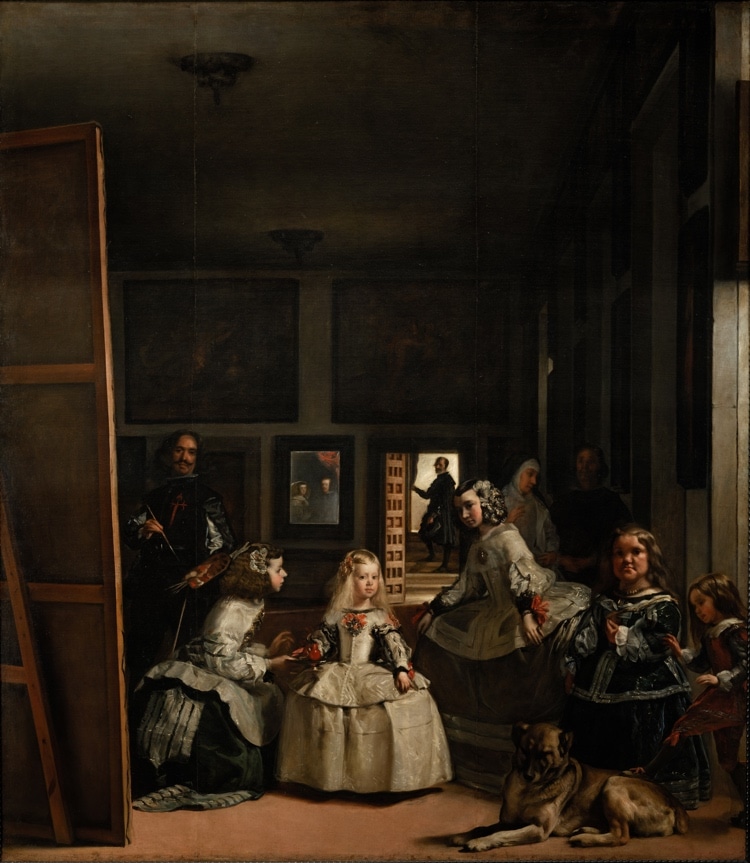
"Las Meninas" by Diego Velázquez, 1656. (Photo: Wikiart, Public domain)
This post may contain affiliate links. If y'all make a purchase, My Mod Met may earn an affiliate committee. Delight read our disclosure for more than info.
For over 350 years, art lovers have been fascinated by Las Meninas . This complex oil painting by Diego Velázquez is an incredibly nuanced depiction of life in the courtroom of King Philip Four of Spain. Mayhap one of the near important paintings in all of Western art history, this masterpiece from 1656 continues to influence artists today.
The championship, which translates toLadies in Waiting, is a turning point in art history for the way in which Velázquez broke from the stiff formal portraits that typically divers royalty. The big canvas shows Infanta Margaret Theresa, the rex's daughter, surrounded by her entourage as Velázquez stands behind an easel painting her portrait.
At present housed in Madrid's Prado Museum,Las Meninasis a highlight of Velázquez'due south achieved portfolio of work. Merely what is it nearly this masterpiece that has intrigued the public for centuries? What makes it so groundbreaking and what was Velázquez trying to convey through the painting? Let's take a look at what makesLas Meninasso iconic and the legacy that it'southward left behind.
Who is Diego Velázquez?
The homo behind the painting, Diego Velázquez, was a leading figure through the Spanish Golden Age of art and literature. This explosion of culture in Kingdom of spain ran parallel to the flourishing of the Castilian Habsburg dynasty. The rise of the Habsburgs and the expansion of the Spanish Empire was fantastic news for an artist like Velázquez, who saw his career have off as the court painter for Male monarch Philip IV.
The Castilian painter'south career spans the same period as the great Baroque artists of Italia and France, yet he developed his own distinct mode. Born in Seville, his early work is filled with scenes known every bit b odegón. Particular to Spain, these paintings of daily life took place in the kitchen and feature elements of still life.
Velázquez's career took off when he moved to Madrid. When Philip's court painter died, Velázquez filled the office and became increasingly known for his portraiture. Non just was Velázquez able to capture the concrete likeness of his subjects, but his use of loose brushstrokes to create texture and movement in clothing was revolutionary. His work would be highly influential to later on painters like Manet and the Impressionists, who built on the foundations of what he started.
Las Meninas
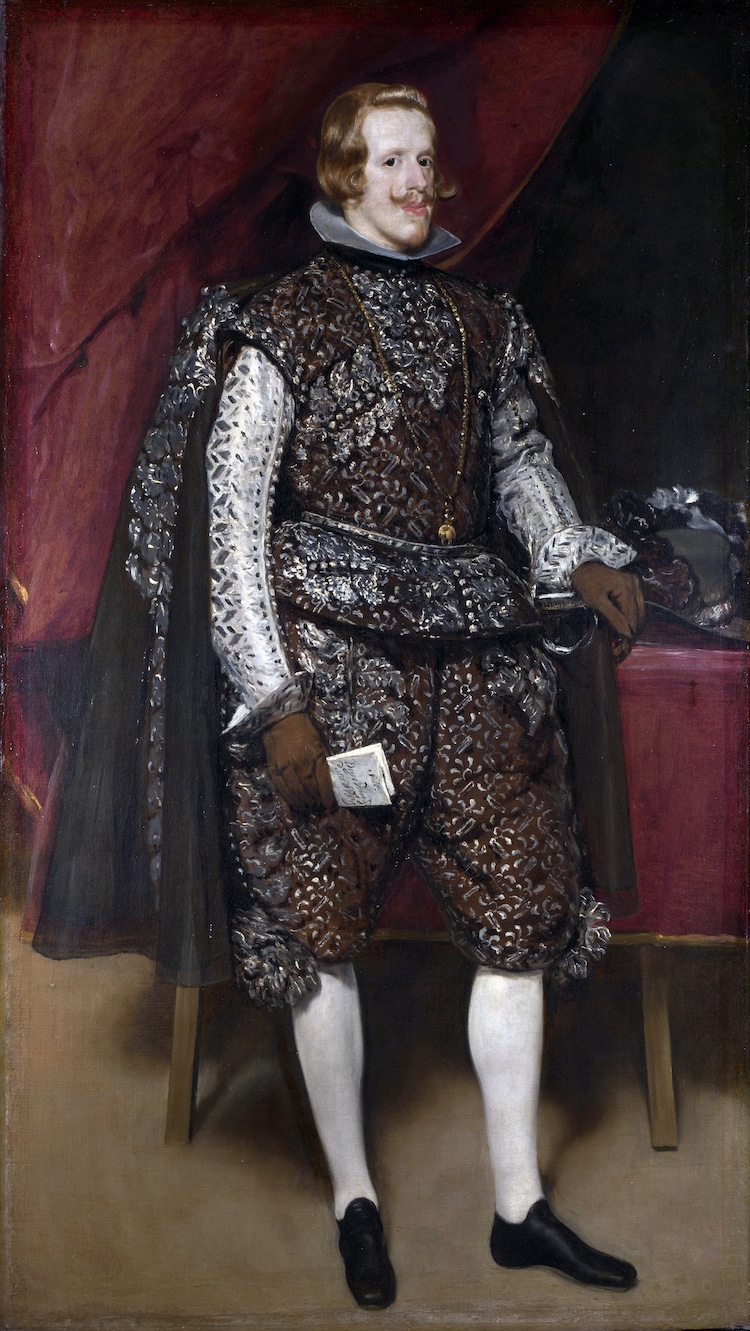
"Philip Iv in Brown and Silvery," circa 1631-1632. (Photograph: Wikipedia, Public domain)
By the fourth dimension Velázquez paintedLas Meninas, he'd been working at the court of King Philip IV for over 30 years. In that time, he'd made himself indispensable and had been by the king'due south side, as his first married woman and their but son had died. At the fourth dimension of the painting, Rex Philip had remarried Mariana of Austria, and Margaret Theresa (the immature girl at the center of the painting) was their first and only girl.
Commissioned by Philip, the painting was hung in his private office at his summertime palace. Until 1819 it remained in the royal palace, after which time it went into the collection of the Prado Museum. Much of what we know virtually the painting is owed to Spanish writer Antonio Palomino, who dedicated an entire section of his volume on Spanish artists to Las Meninas. He not only gave the yr that the painting was created, but also identified almost of the people within the canvas. Information technology's too thanks to Palomino that nosotros know that it shows a room located within the Royal Alcázar. This fortress turned palace was the seat of the Habsburg rulers.
Main figures inLas Meninas
With and then many people in one canvas, information technology's vital to empathise who each person is and what their role was inside the Habsburg courtroom.
Infanta Margaret Theresa
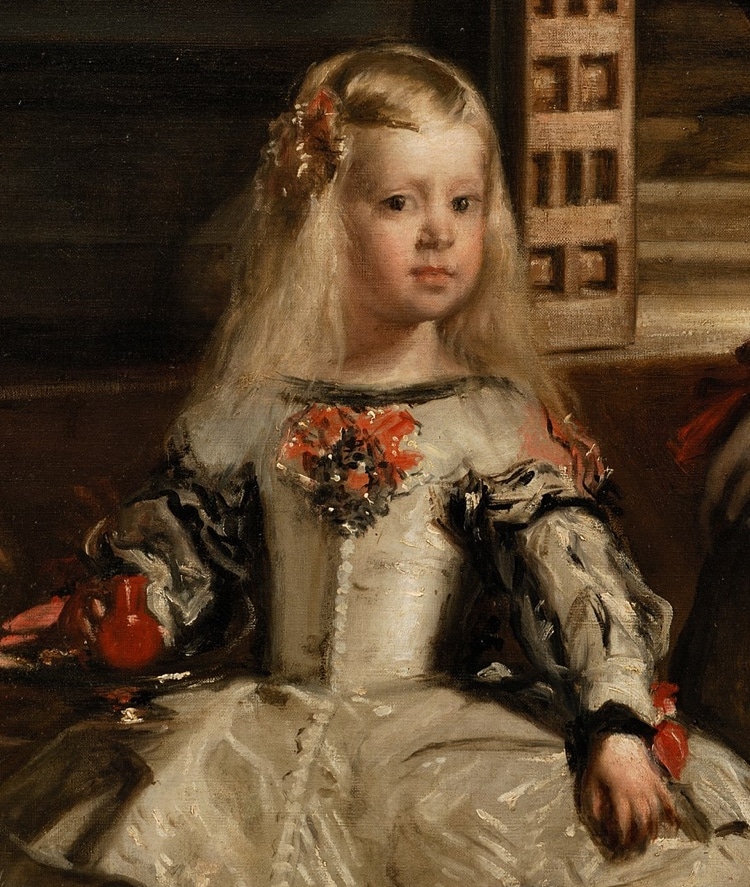
The young princess would have been most 5 years quondam whenLas Meninaswas painted. Though Philip had 12 children between his two wives, Margaret Theresa was only one of two to survive into adulthood. She later became the Holy Roman Empress when she married Leopold I. Here she is being attended by two ladies in waiting and dressed in the full splendor that one would expect from a immature Habsburg. Interestingly, her gaze doesn't fall on either of her ladies-in-waiting, just direct outward at whoever is standing behind Velázquez'due south easel.
María Agustina Sarmiento and Isabel de Velasco
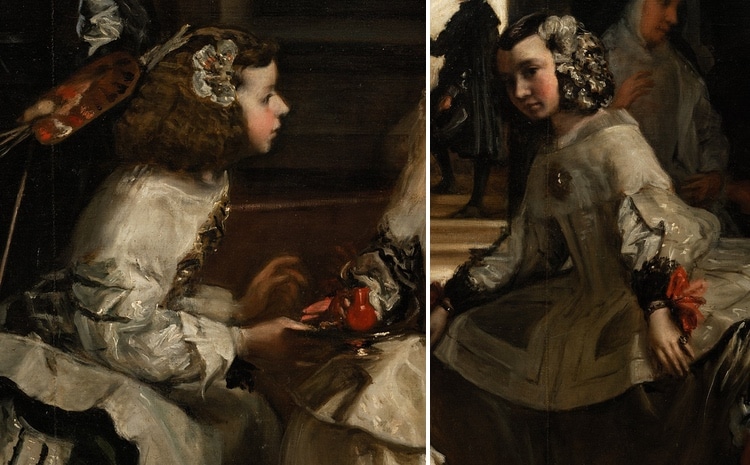
Standing on either side of Margaret Theresa are her ladies-in-waiting (meninas).Isabel stands on the young princess's left, ready to curtsey. María Agustina instead knees earlier her and offers her something to drink on a tray.
Maria Bárbola and Nicolasito Pertusato
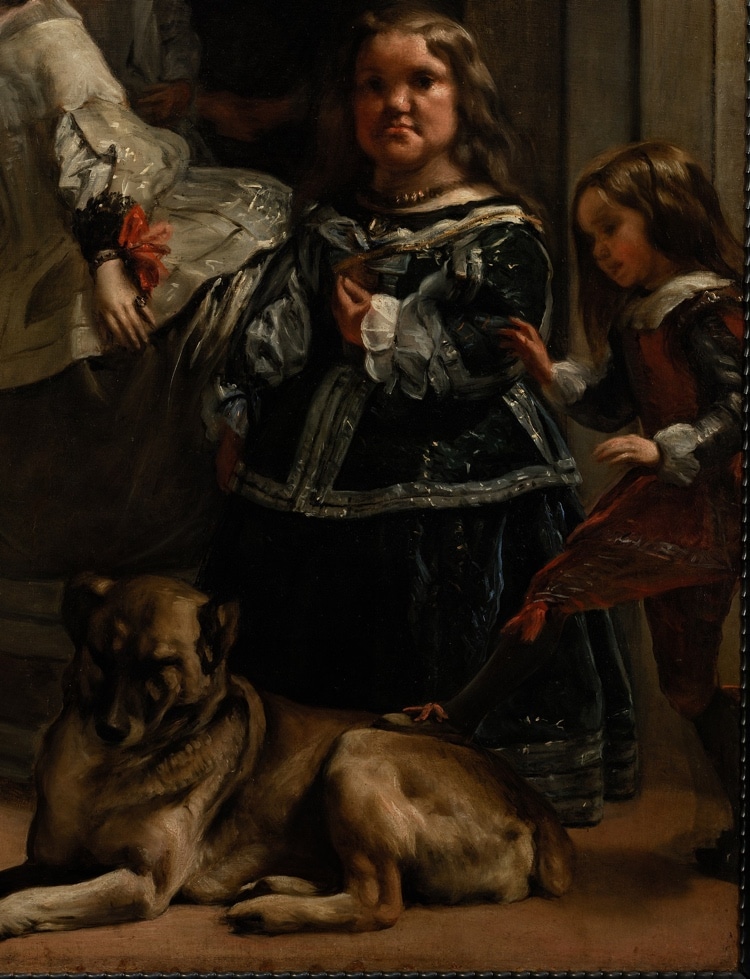
Two dwarves—the German language Bárbola and Italian Pertusato—stand on the righthand side of the canvas. Pertusato's foot is placed on the dorsum of a dog, as though he's trying to wake him from slumber. The canis familiaris is a wonderful example of a Castilian mastiff, which were bred as guard dogs and protected flocks of sheep. Dwarves had an important part in Philip'southward court and their prominence is highlighted by Velázquez's numerous portraits of court dwarves.
Marcela de Ulloa
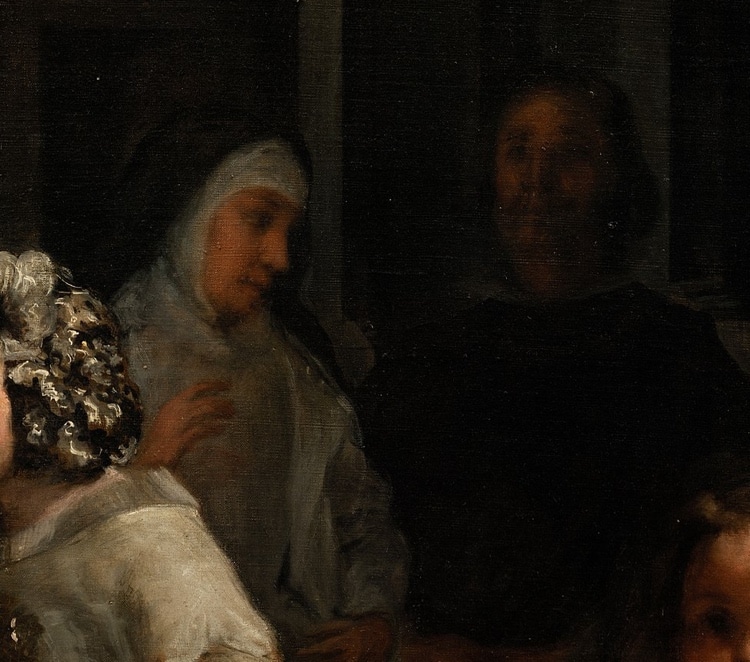
Standing just backside Isabel de Velasco is Margaret Theresa's chaperone Marcela de Ulloa. She is dressed in mourning and chats with an unidentified figure who is probably a bodyguard.
José Nieto
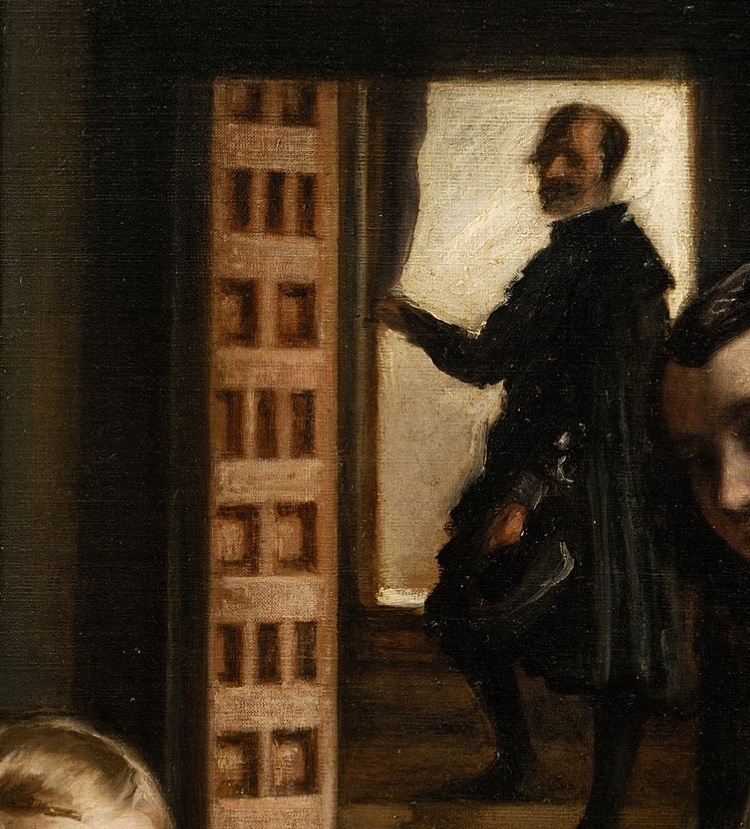
The queen's chamberlain José Nieto is given prominence in the portrait thanks to his placement in the doorway. Nieto was as well the head of tapestry works at the court and may take been a relative of Velázquez. It looks as though he is pushing aside a pall in the doorway, perhaps to let in more natural lite while the painter works.
King Philip Four of Spain and Mariana of Austria
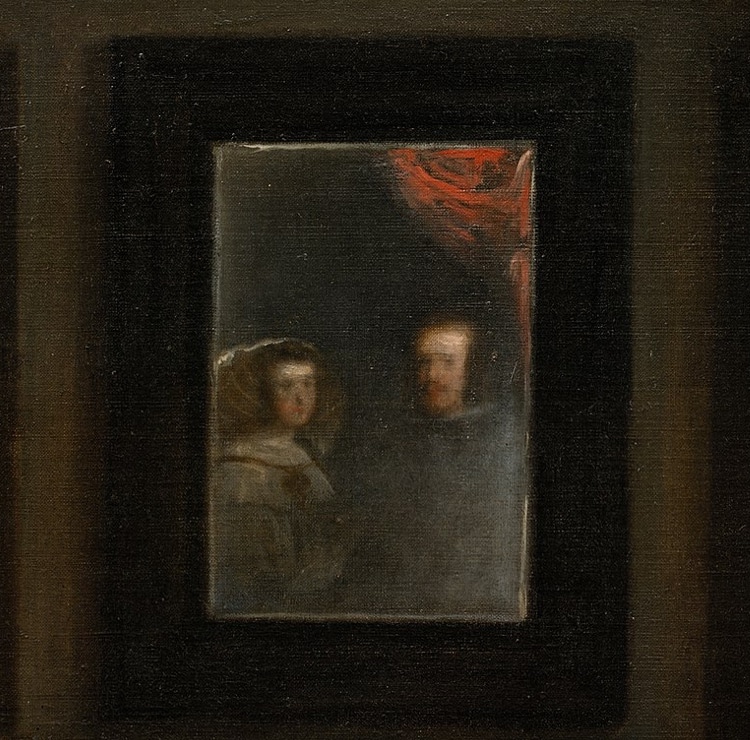
While it may non be immediately clear whom the young Margaret Theresa is looking at, not bad observers will notice a couple reflected in the mirror at the dorsum of the room. Here we meet the figures of King Philip IV and his queen, Mariana of Austria. And once we consider that we too see Velázquez painting at his easel, things get clearer—she'southward looking at her parents. The apply of mirrors and reflection in the painting is most likely due to the influence of January Van Eyck's Arnolfini Portrait.Painted in 1434, this masterpiece of the Northern Renaissance was hung in Philip's palace, then Velázquez would take surely seen information technology.
Diego Velázquez

While it's certainly not uncommon for artists to include themselves in paintings—Raphael featured himself inThe School of Athens—Velázquez gives his self-portrait a prominent position in the painting. Not only doesLas Meninasaccept identify within his painting studio at the Alcázar, merely everything in the piece of work revolves around the painter's actions. Working not only as court painter only also as the curator of Philip's expansive fine art collection, Velázquez's part was vital to the courtroom'south cultural life. Here, the Spanish painter shows himself in front of a canvass working on a portrait of the royal couple.
What does Las Meninas Mean?
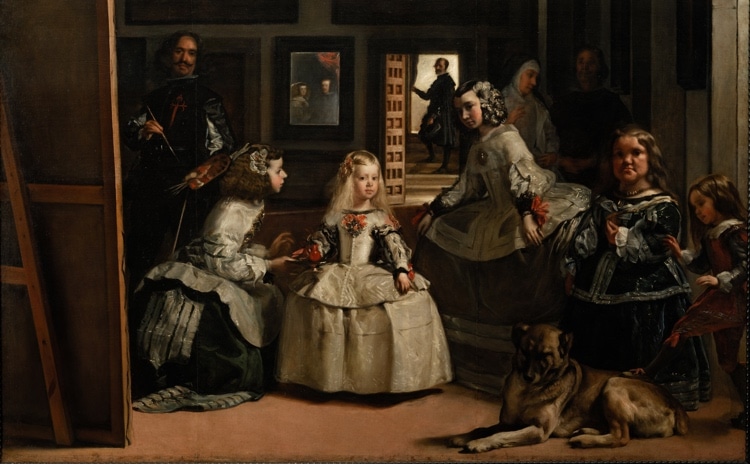
The fascinating painting places viewers in the position of the rex and queen. This interesting twist makes whoever is looking at the painting both a spectator and a participant. Of grade, originally the spectator would accept been Philip, every bit it hung in his office. Considering this, Las Meninasshows the menagerie of characters who would have been important to the king himself.
Some art historians have seen the work as a style for Velázquez to show off his own importance within the court. By elevating himself beyond the "mechanical" art of painting, he was displaying his worthiness. This would take been important when one considers a small-scale detail in how the artist depicts himself.
The ruby-red cross on his chest is the symbol of the Order of Santiago, a prestigious religious and military machine order. Exceedingly difficult to enter, he was admitted to the gild in 1659 upon a decree of the king. While it was one time thought that he added the cross to his breast at a later appointment, new conservation studies show that this was not the case. Could information technology be that the artist was pushing his own agenda prior to his knighthood?
Art historian Jonathan Brown, a leading adept on Velázquez, has posited another theory. He argues that the painting was fabricated in between when the creative person was knighted in 1659 and when he assisted Philip on an important political trip to France in 1660. Chocolate-brown has theorized thatLas Meninaswas a sort of give thanks you gift to Rex Philip for knighting Velázquez.
Whatever the case,Las Meninashas remained intriguing for the complex game between painter, model, and viewer. Who is looking at who? And why? It's an unsolved mystery that delights fine art lovers.
The Influence of Las Meninas
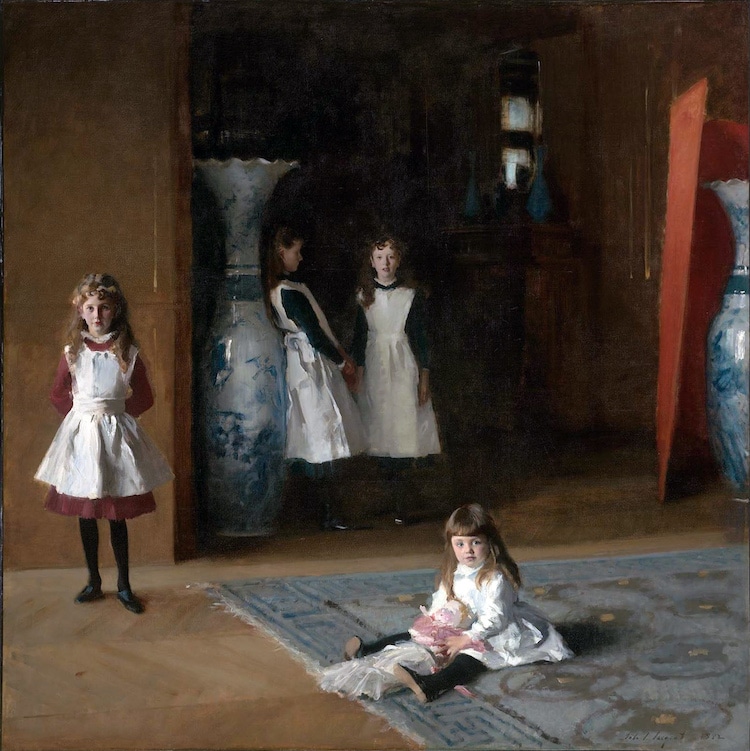
"The Daughters of Edward Darley Boit" past John Vocaliser Sargent, 1882. (Photograph: Wikipedia, Public domain)
Las Meninasonly grew in influence equally the piece of work of Velázquez began to gain prominence internationally in the 19th century. Pablo Picasso was especially enamored withLas Meninas. The Cubist genius painted 58 variations on the work in 1957. Salvador Dalí painted his own homage to the work in 1958 with a piece titledVelázquez Painting the Infanta Margarita With the Lights and Shadows of His Own Glory.He would continue to return to the theme, painting work inspired byLas Meninasthroughout his career.
While Picasso and Dalí's pieces functioned every bit a direct homage to their fellow Spaniard, other painters took the lessons ofLas Meninasand used them to heighten their portraiture. The most famous case is John Singer Sargent's 1882 oil painting,The Daughters of Edward Darley Boit.Sargent'southward utilize of infinite, moving from the night background to light foreground, besides as his loose brushstrokes and composition of figures were certainly influenced byLas Meninas.
Las Meninas' Location Today
The x′ 5″ 10 9′ Las Meninas painting now hangs in the Museo Nacional del Prado in Madrid, Spain, and is a national treasure to the Castilian people. Its cultural value is costive, and as such, volition most likely never leave Prado'due south collection or ever travel for exhibits. The oil painting tin be viewed in room 012 in the Museo del Prado.
This article has been edited and updated.
Related Articles:
The Story Behind Seurat's Pointillist Masterpiece, 'A Lord's day Afternoon on the Island of La Grande Jatte'
How Delacroix Captured France'southward Revolutionary Spirit in 'Liberty Leading the People'
How This One Painting Sparked the Impressionist Movement
15 Facts You Demand to Know About the Delightfully Weird 'Garden of Earthly Delights'
hylandpromicame1959.blogspot.com
Source: https://mymodernmet.com/diego-velazquez-las-meninas/
0 Response to "Diego Velazquez Position in Art History Diego Velazquez Paintings Vs Impressionism"
Post a Comment